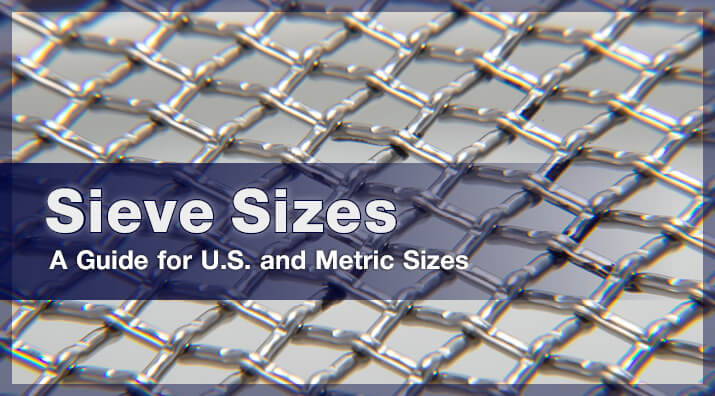
Selecting Sieve Sizes for Sieve Analysis
Selecting suitable test sieves with the correct openings ensures accurate particle sizing and characterization of soils, aggregates, grains, powders, and other materials while following ASTM and AASHTO standard test methods.
Sieving Standards
ASTM and ISO specifications establish requirements for wire diameter, aperture (opening) size, and other features of test sieves:
- ASTM E11 specifies technical requirements for standard, alternative, and supplementary sizes of woven wire sieve cloth, sieve construction, frame sizes, and inspection of sieves and sieve cloth for sieves from 125mm to 20µm (5.0 to No. 635). AASHTO M 92, discontinued after 2010, was equivalent to the E11 standard and used the same dimensions and tolerances.
- ISO 565 establishes nominal metric opening dimensions of woven-wire sieves for principal and supplementary sizes from 125mm to 20µm.
- ISO 3310-1 specifies tolerances and allowable standard deviations for wire diameters and apertures of principal and supplementary sieves. This standard also lists requirements for sieve frame types and sizes.
In addition to these standards describing test sieves, there are many published test methods from ASTM and other industry-related organizations that specify procedures for particle size sieve analysis of particular materials. A few examples are:
- ASTM C33 for concrete aggregates
- ASTM D6913 for soils
- ASTM B214 for powdered metals
- USP32-NF27 (786) for pharmaceutical products
Other industries have unique test sieving methods that apply to foods, paints, and other granular materials.
Test Sieve Configurations: What’s Available
Gilson test sieves are available with brass or stainless-steel frames fitted with brass or stainless steel woven-wire cloth meeting ASTM or ISO standards. Brass sieve cloth is limited to opening sizes from 2.36mm to 45µm (No. 8 to No. 325) for mounting in 8in or 12in (203mm or 305mm) brass frames. Although all stainless-steel sieves are more durable and often less expensive, all-brass sieves are still useful in some applications, such as those requiring non-sparking equipment.
Gilson carries popular frame diameters of 3in (76mm), 8in (203mm), and 12in (305mm), and many mesh sizes in ISO 200 mm and 300 mm frames in stock for immediate shipment. Other frame sizes, including 6in (152mm), 10in (254mm), and 18in (457mm), can be ordered. Unmounted ASTM Wire Cloth is also in stock. The sheet material is cut-to-order and meets ASTM E11 standards for opening sizes and wire diameters.
Test sieves are constructed with full-height or half-height frames. Full-height frames offer more space for agitation of larger particles, and half-height frames allow more sieves to be used in the same stack height when using a sieve shaker. 12in (305mm) diameter sieves also feature an option for intermediate-height frames.

You may need to factor in many different criteria to select the proper test sieves for your application. Our What Is A Sieve? blog post and this video will help you understand test sieves and the choices available to you.
U.S. and Metric Sieve Sizes: Not That Different
This table lists nominal ASTM sieve sizes in standard millimeter (mm) or micrometer (µm) units, along with equivalent U.S. alternative sizes by inch and mesh number (No.) designation. ASTM E11 now designates supplemental metric sizes that fill in the gaps between ASTM and ISO sizes. Corresponding ISO sizes in mm/µm are included.

See Complete U.S. Standard Sieve Sizes Table Below
Sieve Size Definition
Sieve opening sizes were initially defined in ASTM standards using imperial (inch) units of measure for apertures 1/4in (6.3mm) or above. Mesh number sizes for finer sieve cloth were determined by counting the number of apertures per linear inch. So, a No. 4 Sieve would have four openings in every linear inch. ISO openings are described in millimeters (mm) or micrometers (µm).
As a result of efforts toward harmonizing the standards, ASTM and ISO sieve specifications and tolerances are now very similar and, in many cases, identical. Both standards include specific requirements for aperture dimensions, mesh size, and statistical variations. For example, an ASTM 3/8in test sieve and an ISO 9.5mm sieve have identical opening sizes, wire diameter, and measurement tolerances and can be used interchangeably. Although popular ASTM 8in and 12in (203mm and 305mm) diameter sieve frames will not nest with ISO 200mm and 300mm frames, most sieve cloth sizes are available mounted in either size frame.
Also contained within ASTM E11 is a range of additional opening sizes classified as “supplementary sizes.” These 40 supplemental sizes fill in some gaps in the traditional ASTM lineup and are offered by Gilson mounted in 3in, 8in, and 12in (76mm, 203mm, and 305mm) stainless steel frames.
Different Needs for Different Industries
Different industries often specify a certain sieve size or set of sieve sizes to define particular material types. Particle sizing determinations are not limited to these sieve sizes, but they provide boundaries to classify the materials. The two examples shown below are for mineral aggregates used for the production of asphalt and concrete mixes, and for soils used in geotechnical engineering applications.
- Mineral aggregates for use in asphalt and concrete mixes are classified as coarse or fine. Coarse sieve sizes include sieves with openings larger than 4.75mm (No. 4), and fine sieve sizes are smaller than 4.75mm (No. 4), ranging down to 75µm (No. 200). The table below includes fine and coarse aggregate sieve sizes.
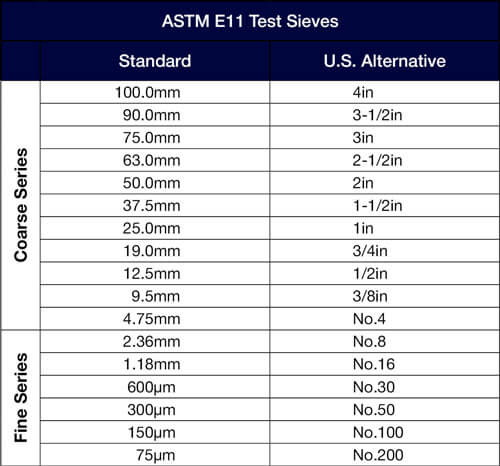
- For geotechnical engineering, gradation testing of soils using test sieves is governed by ASTM D6913 for soil particles as fine as 75µm (No. 200 sieve size). For soils with significant silt or clay fractions, the ASTM D7928 hydrometer test is used to determine fine particle sizes in liquid suspension, as described in our Soil Hydrometer Testing blog post. The table below includes standard sieve sizes for soils.
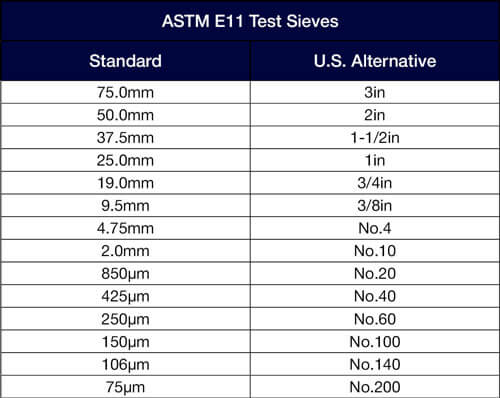
Sieve Verification: Upgrading for Accuracy
Conventional ASTM or ISO sieves are constructed using woven wire mesh that has been measured and inspected in the bulk form before being mounted in the sieves. These accurate and reliable sieves are standard, off-the-shelf test sieves intended for everyday use. They are classified as Compliance sieves and supplied with certificates of manufacturing compliance.
For applications where a higher level of accuracy, documentation, or traceability of sieving equipment is required, sieve verification services measure intact test sieves on NIST traceable instruments. They can provide two different levels of documentation that opening sizes and wire diameters meet or exceed ASTM/ISO specifications:
- Inspection sieves have a 99% statistical confidence level that the standard deviation of the opening sizes is within the maximum allowed. Inspection Sieves are a good option when accuracy and repeatability are critical.
- Calibration sieves have twice as many openings measured, increasing the confidence level to 99.73% that the standard deviations of the apertures are within the maximum. Calibration Sieves are an excellent choice when a very high degree of accuracy is required.
How to Check Sieve Sizes
Sieves are subjected to hard use, whether in a sieve shaker or with manual sieve techniques. Sample loads cause distortion of the woven-wire mesh and abrasion results in a reduction of wire diameters, enlarging the openings beyond acceptable limits. Other options for ongoing validation of sieve accuracy and conformity are also available:
- Reverification of used sieves is available to maintain the status of certified Inspection and Calibration sieves.
- Master-Matched Sieves are first verified to Inspection grade, then compared to Gilson Master Sieves by performance testing with NIST traceable Standard Reference Materials. Master-Matched sieves are designed for inclusion in an internal QCQA program.
- Standard Reference Materials (SRMs) are precision-sized powders or glass beads to test the performance of sieves and calculate effective opening sizes. SRMs can also be used to determine the size of mesh openings if not known.
- Sieve Inspection Tools can be used for direct measurements of mesh size of sieve openings and close inspection for damage. Measurements with these instruments do not qualify as verification but are useful as a maintenance and quality control strategy to monitor the general condition of each sieve.
Sieve Pans and Covers: Protecting and Collecting Your Samples
Sieve pans and covers collect fine material passing the sieves and prevent sample loss during handling and testing.
- Sieve pans are available in brass or stainless-steel models in full-height or half-height versions to adapt to your testing applications. Extended-rim sieve pans feature a built-in skirt for nesting in the middle of a sieve stack, allowing two samples to be processed in the same stack.
- Sieve covers are lids that nest into the top of a sieve to prevent sample loss, contamination, or changes in moisture during agitation or handling.
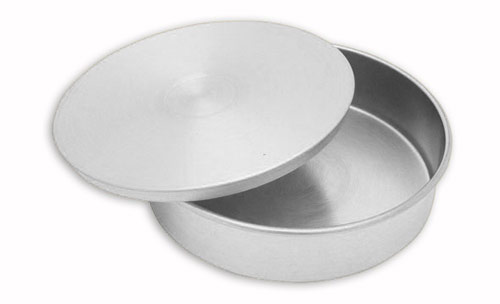
Backing Cloth: Making Your Sieves Last
Backing cloth reinforces finer mesh sizes to stop sagging, tearing, and distortion of the mesh openings from repeated use. This factory-installed No. 30 (600µm) stainless steel backing preserves sieve accuracy and extends service life. Backing cloth can be ordered at the time of purchase for 8in or 12in (203mm or 305mm) diameter sieves with mesh sizes finer than No. 70 (600µm). The backing is positioned under the primary mesh, so verification of Inspection or Calibration grades is not possible after the backing is installed.
Test Sieving Methods Manual
The ASTM Manual on Test Sieving Methods, also known as Manual 32, offers well-researched guidelines for establishing sieve analysis procedures. The most recent 6th edition from committee E29 has updated information for sieves, sieving equipment, and procedures that correlate with ASTM standards across many industries. Revised tables, charts, and specifications are included.
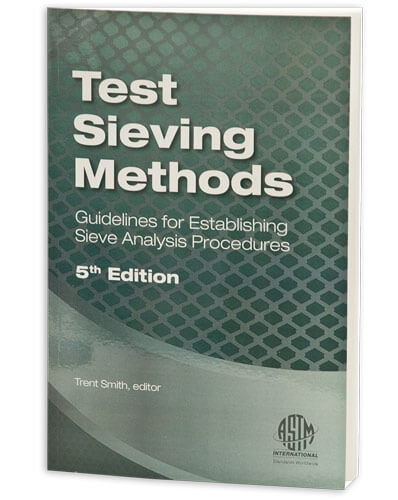
Understanding Common Sieving Terms
Words and terms used in sieving can be confusing. Some sieving terms are unique to the industry, and others are used interchangeably, e.g., aperture size and mesh opening, or micron and micrometer. A complete listing of sieving terminology is found in ASTM E1638.
| Term | Definition |
| Aperture Size or Mesh Opening | The measured opening in a screening or sieving medium |
| Backing Cloth or Backup Cloth | Coarse wire cloth installed under test sieve cloth as reinforcement for finer sieve mesh |
| Calibration Test Sieve | A manufactured test sieve that has had a specified number of openings measured. There is a confidence level of 99.73% that the standard deviation of the openings is within the requirements of ASTM E11 or ISO 3310-1. Also, see Compliance Test Sieve and Inspection Test Sieve |
| Certified Sieve | A test sieve that has been examined and certified by an authority, accredited for the purpose, as complying with the specifications and tolerances of the applicable standard. Also, see Verified Sieve |
| Compliance Test Sieve | Test sieves manufactured using sieve cloth with a specified number of openings measured prior to mounting in the sieve frame. There is a confidence level of 66% that the standard deviation of the openings per 100 square feet of sieve cloth is within the requirements of ASTM E11 or ISO 3310-1. Also, see Inspection Test Sieve and Calibration Test Sieve |
| Extended Rim Pan | A pan with a nesting skirt is used in a stack of sieves to permit two or more separate sieve tests to be made simultaneously, usually with a mechanical sieve shaker. Also, see Pan with Skirt and Nesting Pan |
| Fines | Any material passing the finest sieve used in a sieve analysis |
| Gradation Analysis | The process by which determines the particle size distribution. Also, see Sieve Analysis and Particle Size Analysis |
| Inspection Test Sieve | A manufactured test sieve that has had a specified number of openings measured. There is a confidence level of 99% that the standard deviation of the openings is within the requirements of ASTM E11 or ISO 3310-1. Also, see Compliance Test Sieve and Calibration Test Sieve |
| Matched Test Sieve | A test sieve that reproduces the performance results of another test sieve within user-defined limits for a designated material |
| Mesh | The number of wires or openings per linear inch (25.4 mm), counted from the center of any wire to a point exactly one inch (25.4 mm) distant, including the fractional distance between either. For example, a No. 4 (4.75mm) sieve has four holes per inch, while a No. 18 (1.04mm) has 18 |
| Micron or Micrometer | A common reference to particle size or opening dimension, properly defined as a micrometer |
| Nest | When a sieve with a skirt is stacked on top of another sieve of the same diameter, the two sieves are nested. Also, see Stack |
| Nesting Pan | A pan with a nesting skirt is used in a stack of sieves to permit two or more separate sieve tests to be made simultaneously, usually with a mechanical sieve shaker. Also, see Pan with Skirt and Extended Rim Pan |
| Nominal Size | The specified dimension of the opening of a sieve about which the actual size is permitted to vary |
| Pan | A pan that fits snugly beneath a sieve to receive the passing fraction. Also, see Receiver |
| Pan with Skirt | A pan with a nesting skirt is used in a stack of sieves to permit two or more separate sieve tests to be made simultaneously, usually with a mechanical sieve shaker. Also, see Extended Rim Pan and Nesting Pan |
| Particle Size | The dimension of a particle is usually expressed in terms of the smallest sieve opening through which it will pass |
| Particle Size Analysis | The process by which the particle size distribution is determined. Also, see Gradation Analysis |
| Particle Size Distribution | In sieve analysis, the percentages, by mass or number, of all fractions into which various sizes of particles are classified |
| Particle Size Distribution Graph | A graph that defines the gradation of material, showing particle sizes plotted against the percent passing a series of test sieves or retained on each sieve. Also, see Size Distribution Graph |
| Receiver | A pan that fits snugly beneath a sieve to receive the passing fraction. Also, see Pan |
| Screen | (1) a surface provided with apertures of uniform size and shape; (2) another term used interchangeably for woven wire cloth; (3) a machine provided with one or more screen surfaces |
| Shute Wires | The wires running the short way of, or across the cloth as woven (also referred to as the shoot, fill, or weft wires)¹ |
| Sieve | A sieve manufactured by mounting sieve cloth, electroformed material, or perforated plate in a frame, designed for use in particle size analysis by sieving. Also, see Test Sieve |
| Sieve Analysis | The process by which the particle size distribution is determined. Also, see Gradation Analysis and Particle Size Analysis |
| Sieve Certification | The process of inspecting and measuring the construction, opening size, and wire diameter of a test sieve to document its compliance with published specifications. Also, see Sieve Verification |
| Sieve Cloth | Woven wire cloth with controlled aperture sizes conforming to ASTM E11 or ISO 3310-1 |
| Sieve Cover or Lid | A cover with a skirt that fits the top of a test sieve to prevent sample loss during testing |
| Sieve Frame | A rigid framework that supports the sieving medium and limits the spread of the material being sieved |
| Sieve Series | A group of sieves with a mathematically defined set of opening sizes, wire diameters, and tolerances |
| Sieve Shaker | A device that agitates the sample material in a stack of test sieves for particle size determinations |
| Sieve Skirt | The portion of the sieve frame that extends below the sieving surface and nests into the next finer sieve or receiving pan |
| Sieve Stack | A series of sieves, progressing from larger to smaller openings are nested on top of one another for particle size distribution tests. A sieve stack is usually used in a sieve shaker |
| Sieve Verification | The process of inspecting and measuring the construction, opening size, and wire diameter of a test sieve to document its compliance with published specifications. Also, see Sieve Certification |
| Size Distribution Graph | A graph that defines the gradation of material, showing particle sizes plotted against the percent retained or percent passing a series of test sieves. Also, see Particle Size Distribution Graph |
| Standard Reference Materials | Glass beads or other particles of known sizes are measured by established methods. Used to measure the average opening sizes of test sieves |
| Supplemental Sieve | ASTM E11 sieves in sizes that supplement standard sizes and match ISO sieve sizes |
| Test sample | A representative sample that is small enough to use directly in a test sieve or series of sieves |
| Test Sieve | A sieve manufactured by mounting sieve cloth, electroformed material, or perforated plate in a frame, designed for use in particle size analysis by sieving. Also, see Sieve |
| Verified Sieve | A test sieve that has been examined and certified by an authority for the purpose of complying with the specifications and tolerances of the applicable standard. Also, see Certified Sieve |
| Warp Wires | The wires running the long way of the cloth as woven |
| Weft Wires | The wires running the short way of, or across the cloth as woven (also referred to as the shoot, shute, or fill wires) |
| Wire Diameter | The cross-sectional dimension of the wire in woven sieve cloth |
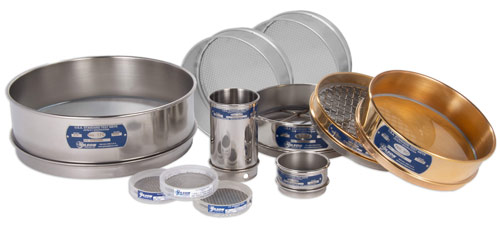
Below you will find a useful ASTM Standard and Alternate, and ISO Sieve Sizes chart. For a PDF copy, print, or download a copy of this sieve size conversion chart, click here.
Metric and U.S. Standard Sieve Sizes Table
| ASTM E11 | ISO 565/3310-1 | |
|---|---|---|
| Standard | Alternate | Size |
| 100.0mm | 4in | - |
| 90.0mm | 3 1/2in | - |
| 75.0mm | 3in | - |
| 63.0mm | 2 1/2in | 63.0mm |
| - | - | 56.0mm |
| 53.0mm | 2.12in | 53.0mm |
| 50.0mm | 2in | 50.0mm |
| 45.0mm | 1 3/4in | 45.0mm |
| - | - | 40.0mm |
| 37.5mm | 1 1/2in | 37.5mm |
| - | - | 35.5mm |
| 31.5mm | 1 1/4in | 31.5mm |
| - | - | 28.0mm |
| 26.5mm | 1.06in | 26.5mm |
| 25.0mm | 1in | 25.0mm |
| 22.4mm | 7/8in | 22.4mm |
| - | - | 20.0mm |
| 19.0mm | 3/4in | 19.0mm |
| 18.0mm | - | 18.0mm |
| 16.0mm | 5/8in | 16.0mm |
| - | - | 14.0mm |
| 13.2mm | 0.530in | 13.2mm |
| 12.5mm | 1/2in | 12.5mm |
| 11.2mm | 7/16in | 11.2mm |
| - | - | 10.0mm |
| 9.5mm | 3/8in | 9.5mm |
| - | - | 9.0mm |
| 8.0mm | 5/16in | 8.0mm |
| - | - | 7.1mm |
| 6.7mm | 0.265in | 6.7mm |
| 6.3mm | 1/4in | 6.3mm |
| 5.6mm | No. 3 1/2 | 5.6mm |
| - | - | 5.0mm |
| 4.75mm | No.4 | 4.75mm |
| - | - | 4.50mm |
| 4.00mm | No.5 | 4.00mm |
| 3.55mm | - | 3.55mm |
| 3.35mm | No.6 | 3.35mm |
| - | 1/8in* | - |
| 3.15mm | - | 3.15mm |
| 2.80mm | No.7 | 2.80mm |
| - | - | 2.50mm |
| 2.36mm | No.8 | 2.36mm |
| 2.00mm | No.10 | 2.00mm |
| - | - | 1.80mm |
| 1.70mm | No.12 | 1.70mm |
| - | - | 1.60mm |
| 1.40mm | No.14 | 1.40mm |
| - | - | 1.25mm |
| 1.18mm | No.16 | 1.18mm |
| - | - | 1.12mm |
| 1.00mm | No.18 | 1.00mm |
| - | - | 900µm |
| 850μm | No.20 | 850µm |
| - | - | 800µm |
| 710μm | No.25 | 710µm |
| - | - | 630µm |
| 600μm | No.30 | 600µm |
| - | - | 560µm |
| 500μm | No.35 | 500µm |
| - | - | 450µm |
| 425μm | No.40 | 425µm |
| - | - | 400µm |
| 355μm | No.45 | 355µm |
| - | - | 315µm |
| 300μm | No.50 | 300µm |
| - | - | 280µm |
| 250μm | No.60 | 250µm |
| - | - | 224µm |
| 212μm | No.70 | 212µm |
| - | - | 200µm |
| 180μm | No.80 | 180µm |
| - | - | 160µm |
| 150μm | No.100 | 150µm |
| - | - | 140µm |
| 125μm | No.120 | 125µm |
| - | - | 112µm |
| 106μm | No.140 | 106µm |
| - | - | 100µm |
| 90μm | No.170 | 90µm |
| - | - | 80µm |
| 75μm | No.200 | 75µm |
| - | - | 71µm |
| 63μm | No.230 | 63µm |
| - | - | 56µm |
| 53μm | No.270 | 53µm |
| - | - | 50µm |
| 45μm | No.325 | 45µm |
| - | - | 40µm |
| 38μm | No.400 | 38µm |
| - | - | 36µm |
| 32µm | No.450 | 32µm |
| 25µm | No.500 | 25µm |
| 20µm | No.635 | 20µm |
We hope this blog post has given you insight on test sieve opening sizes.
Gilson Is Here to Help
Contact our testing experts for more information or to discuss your testing application.
Testing Resources
Standard Test Methods, Specifications, and Practices
Individual test methods and specifications referenced in our product descriptions, blog articles, and videos are available for review or purchase from the professional organizations noted.
- ASTM International (American Society for Testing and Materials)
- AASHTO (American Association of State Highway and Transportation Officials)
- ACI (American Concrete Institute)
- State DOTs (Departments of Transportation)
- ISO (International Organization for Standardization)
- BS (British Standards)
- EN (European Standards)

















